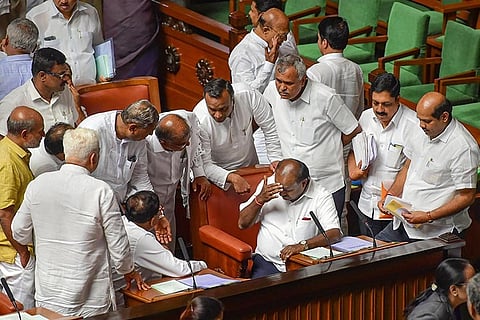

The drama surrounding the Chief Minister's chair in Karnataka continues as an inevitable trust vote looms in the Karnataka Legislative Assembly. This especially after Governor Vajubhai Vala wrote to the CM asking him to prove his majority by 1:30 pm Friday. But what exactly is a trust vote, and what happens at the end of it? Here’s the lowdown.
A ‘trust vote’ or confidence motion has to be moved by an MLA or an MP, and the objective is to find out whether or not the Chief Minister has the ‘trust’ or ‘confidence’ of the House. In the case of Karnataka, the Legislative Assembly now has to vote on whether Kumaraswamy can continue as the Chief Minister.
If Kumaraswamy wins the trust vote, he will continue to be CM. In this case, there cannot be another trust vote for six more months. And if he loses, the ball goes to Governor Vajubhai Vala’s court. The Governor can invite the BJP which has the numerical advantage as of Thursday to form the government. He can also choose to declare President’s rule, and the state will go to elections in six months.
A trust vote can be registered in two ways, with no electronic voting system in place in the Vidhana Soudha. In a voice vote, the Speaker will ask those in favour the motion to say ‘Aye’, and those against the motion to say ‘No’. The Speaker then decides whether the ‘Ayes have it’ or the ‘Noes have it.’
A division of votes can be carried out in multiple ways. Since the Karnataka Assembly does not have an electronic voting system, a vote can be carried out with slips that have ‘Ayes’ and ‘Noes’ on them. However, this method is highly unlikely.
The Speaker can also ask the MLAs to physically stand up for those in favour and against the motion and decide by a manual counting of heads.
He can also employ the roll call method. The Assembly Secretary can do a roll call of members, block by block, recording each vote. The Secretary also records those MLAs who choose to remain neutral.
Numbers
As things stand on Thursday, the number of BJP MLAs in the 224-member House is 105 and the Congress-JD(S) coalition has 99 MLAs including the Speaker. The number of MLAs who were absent in the House on Thursday were 20. These included the 15 rebel MLAs who went to the apex court plus two independent MLAs R Shankar and H Nagesh, BSP MLA Mahesh, Congress MLAs Nagendra B, and Shrimant Patil.
The 15 MLAs who approached the SC are Ramesh Jarkiholi (Gokak), Byrathi Basavaraj (KR Puram), ST Somashekhar (Yeshwanthpura), BC Patil (Hirekerur), Shivaram Hebbar (Yellapur), Prathapgouda Patil (Maski), Mahesh Kumathalli (Athani), K Gopalaiah (Mahalakshmi Layout), AH Vishwanath (Hunasuru). Narayana Gowda (Krishanarajapete), Munirathna Naidu (RR Nagar), Roshan Baig (Shivajinagar), MTB Nagaraj (Hoskote), K Sudhakar (Chikkaballapura) and Anand Singh (Vijayanagara).
Recent crisis
The recent saga had started on July 6 when 10 rebel MLAs of the Congress-JD(S) coalition shifted to Mumbai in a chartered flight after sending their resignation letters to the Speaker. Five others followed suit and the matter had even gone to the Supreme Court, urging the Speaker to accept their resignations swiftly and effectively dislodge the current government.
The Supreme Court in its interim order on Wednesday had given the rebel MLAs the liberty to stay out of the House’s possibilities on Thursday with the possibility of the trust vote taking place on this day itself. However, as things stand the trust vote may only happen as early as Monday.